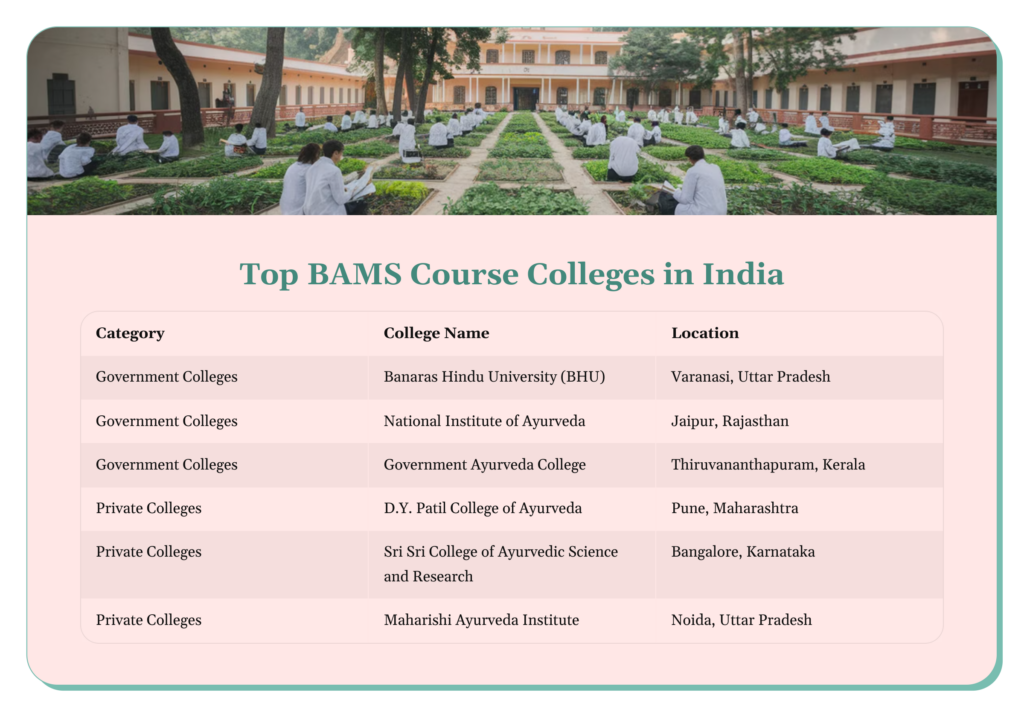
Got a question on this topic?

Quick Summary
Table of Contents

Authored by, Amay Mathur | Senior Editor




Amay Mathur is a business news reporter at Chegg.com. He previously worked for PCMag, Business Insider, The Messenger, and ZDNET as a reporter and copyeditor. His areas of coverage encompass tech, business, strategy, finance, and even space. He is a Columbia University graduate.
The BAMS course (Bachelor of Ayurvedic Medicine and Surgery) is a professional undergraduate program focusing on Ayurveda, one of the world’s oldest complete healing systems. Rooted in ancient Indian medicine, Ayurveda emphasizes natural remedies, preventive care, and balance between mind, body, and spirit. Ayurveda is gaining global recognition and is now an integral part of modern healthcare, creating exciting career opportunities.
A Bachelor of Ayurvedic Medicine and Surgery (BAMS course) program offers a deep understanding of Ayurvedic principles, herbal medicine, and surgical techniques. This course connects students to ancient healing traditions and prepares them for diverse roles in the evolving healthcare industry.
This guide covers everything you need to know about a career in Ayurvedic medicine, from eligibility and syllabus to the admission process, job opportunities, and prospects. It’s designed to help aspiring students make well-informed decisions about their path in this growing field.

The Bachelor of Ayurvedic Medicine and Surgery(BAMS course) is a professional undergraduate degree that provides in-depth knowledge of Ayurvedic medicine, treatments, and herbal formulations. This course integrates traditional healing practices with modern medical sciences, preparing students to become Ayurvedic practitioners, researchers, or educators in alternative medicine.
Ayurveda, meaning “science of life,” is one of India’s oldest medical systems, originating 5,000 years ago. It focuses on natural healing, disease prevention, and balancing the body’s energies—Vata, Pitta, and Kapha. Unlike modern medicine, Ayurveda treats the root cause of diseases rather than just symptoms. It includes treatments such as herbal medicine, yoga, meditation, detoxification (Panchakarma), and dietary therapy, making it a comprehensive healthcare system.
Ayurveda has gained widespread acceptance in recent years and is now integrated into modern healthcare systems. Many hospitals and wellness centers globally incorporate Ayurvedic therapies alongside allopathic treatments. Through the Ministry of AYUSH, the government of India promotes Ayurveda as an essential part of holistic healthcare, ensuring its practice remains scientifically validated and widely accessible.
The World Health Organization recognizes Ayurveda as a traditional medical system and has adopted it in countries like the USA, UK, Germany, and UAE. Ayurvedic wellness centers, herbal medicine production, and alternative healthcare markets have expanded globally. The demand for Ayurvedic practitioners, herbal pharmaceuticals, and therapy specialists is rising, making BAMS an attractive career option for students passionate about holistic medicine and natural healing.
To pursue a BAMS course, students need to complete their 10+2 education from a recognized board with Physics, Chemistry, and Biology (PCB) as core subjects. Most institutions require a minimum of 50% marks for general category students, while reserved category candidates may have some relaxation in scores. Additionally, some universities include English as a mandatory subject to help students better understand medical terms and research materials.
Admission to the BAMS course is based on a student’s performance in the NEET-UG exam, which tests their knowledge of Physics, Chemistry, and Biology. The qualifying scores for NEET change each year, depending on factors like the number of applicants, exam difficulty, and reservation policies. Only those who meet the minimum cut-off can participate in the counseling process, organized by the AYUSH Admissions Central Counseling Committee (AACCC) or state authorities. This process allows seats in government and private Ayurvedic colleges to be allotted based on rank, preferences, and availability.
The Bachelor of Ayurvedic Medicine and Surgery (BAMS) course is 5.5 years long, including 4.5 years of academic study and 1 year of mandatory internship. The program is divided into four professional years, covering Ayurvedic principles, human anatomy, modern medical sciences, and practical training.
The one-year compulsory internship is a vital part of the BAMS journey. It gives students real-world experience in Ayurvedic hospitals, clinics, and healthcare centers. During this time, they get hands-on training in clinical practice, herbal medicine preparation, patient care, and Panchakarma therapy. This practical exposure helps them build confidence and prepares them to handle real medical situations before stepping into their professional careers.
The BAMS course syllabus is structured to offer a balanced mix of Ayurvedic and modern medical sciences: First Year: Anatomy (Rachana Sharir), Physiology (Kriya Sharir), and Ayurvedic Fundamentals (Padartha Vigyan).
The students gain hands-on experience in herbal medicine preparation, diagnosis, Ayurvedic treatments, and surgical techniques. The curriculum includes clinical case studies, lab work, and research-based learning, ensuring they develop theoretical knowledge and practical skills. This well-rounded approach helps them confidently apply Ayurvedic healing methods in real-world patient care.
The Bachelor of Ayurvedic Medicine and Surgery syllabus is designed to provide a comprehensive understanding of Ayurveda, modern medical sciences, and practical applications. It is divided into four professional years and covers various subjects essential for Ayurvedic practice.
The first year of the BAMS course focuses on the fundamentals of human anatomy, physiology, and Ayurvedic principles.
The second year focuses on Ayurvedic pharmacology, toxicology, and disease pathology.
The third year of the BAMS course introduces clinical subjects such as general medicine, pediatrics, and obstetrics.
The final year focuses on surgical procedures, ENT disorders, and detoxification therapies.
The BAMS syllabus ensures holistic learning, equipping students with clinical, theoretical, and practical expertise in Ayurvedic and modern medicine.
The admission process for the BAMS course is conducted through centralized counseling based on NEET (National Eligibility cum Entrance Test) scores. Candidates must follow a structured application and selection process to secure a seat in government or private Ayurvedic colleges.
The NEET-UG application process begins in December/January, followed by the exam in May. Results are typically announced in June, and the counseling starts in July. Candidates must regularly check the official AACCC website or respective state counseling portals for important dates related to registration, choice filling, and seat allotment.
The BAMS course counseling process is conducted in multiple rounds by AACCC for all India quota seats and state authorities for state quota seats. Candidates are allotted seats based on NEET rank, category, and availability. After the first round, those who do not receive a seat or wish to upgrade can participate in subsequent rounds. A mop-up round is conducted for vacant seats. Once allotted, candidates must confirm admission by paying fees and submitting documents.
Government colleges follow reservation policies as per government regulations. Seats are allocated based on General, SC/ST, OBC, EWS, and PwD categories. 85% of seats are reserved for the state quota and 15% for the all-India quota. Private colleges also offer management quota seats for direct admissions with higher fee structures.

BAMS graduates have diverse career opportunities in clinical practice, research, academia, and the pharmaceutical industry. They can work in Ayurvedic hospitals, wellness centers, and government healthcare programs or start their practice. Higher studies like MD/MS Ayurveda enhance specialization. With rising global demand for holistic healthcare, BAMS professionals find rewarding careers in alternative medicine and herbal product development.
BAMS graduates can start their Ayurvedic clinics, providing herbal treatments, Panchakarma therapy, and lifestyle counseling. With rising demand for natural and alternative medicine, private practice offers financial stability and the opportunity to build a loyal patient base.
Many Ayurvedic hospitals and wellness centers hire BAMS professionals as Ayurvedic practitioners, consultants, and therapists. Graduates can work in government and private hospitals, handling chronic diseases, detoxification therapies, and post-operative care.
After completing BAMS, students can specialize by pursuing an MD (Doctor of Medicine in Ayurveda) or MS (Master of Surgery in Ayurveda). These degrees enhance knowledge in Kayachikitsa (General Medicine), Shalya Tantra (Surgery), and Panchakarma Therapy.
Popular specializations include Dravyaguna (Pharmacology), Roga Nidana (Pathology), Kaumarbhritya (Pediatrics), and Prasuti Tantra (Obstetrics & Gynecology). Specialization improves career prospects and allows practitioners to focus on specific Ayurvedic treatment and research areas.
BAMS graduates also find opportunities in Ayurvedic wellness tourism, healthcare startups, and government organizations like AYUSH.
Fresh BAMS graduates can expect an average starting salary of ₹3-5 LPA in government hospitals, private clinics, and Ayurvedic wellness centers. Those working in research or pharmaceutical companies may earn between ₹4-6 LPA. Salaries vary based on location, employer, and specialization.
With 5-10 years of experience, Ayurvedic practitioners can earn ₹8-15 LPA, especially in private practice. Specialists with an MD/MS in Ayurveda can command higher salaries, exceeding ₹20 LPA in hospitals, academia, and wellness tourism. Entrepreneurship in Ayurvedic product manufacturing can further boost earnings.
With a global shift towards holistic healing and natural therapies, Ayurveda is gaining widespread acceptance. Increased awareness about herbal medicine, detox therapies, and lifestyle-based treatments has boosted the demand for qualified BAMS professionals. Government initiatives like the Ministry of AYUSH and schemes promoting Ayurvedic research and healthcare integration are further expanding opportunities. Many Ayurvedic hospitals, wellness centers, and integrative medicine clinics are emerging worldwide, creating a growing need for skilled Ayurvedic practitioners.
BAMS professionals have excellent career prospects internationally, particularly in the USA, UK, Canada, Germany, and UAE, where Ayurvedic wellness is becoming popular. Many Ayurvedic pharmaceutical companies, yoga retreats, and alternative medicine centers recruit BAMS graduates—additionally, organizations like WHO recognize Ayurveda, which leads to increased research funding and global collaboration. With the rising acceptance of Ayurveda in integrative healthcare, BAMS graduates can establish successful careers both in India and abroad.
The Bachelor of Ayurvedic Medicine and Surgery (BAMS) course offers a promising career for individuals passionate about holistic healing and traditional medicine. With the growing acceptance of Ayurveda in mainstream healthcare, BAMS graduates have opportunities in clinical practice, research, academia, and the pharmaceutical industry. The demand for natural and alternative medicine is rising globally, creating rewarding career prospects in hospitals, wellness centers, and Ayurvedic product manufacturing.
BAMS provides a fulfilling and stable career for those dedicated to natural healing, herbal medicine, and preventive healthcare. Whether practicing Ayurveda, pursuing higher studies, or exploring global opportunities, a BAMS degree ensures a bright and impactful future in healthcare.
Also Read: How to Become a Nutritionist in India
Bachelor of Ayurvedic Medicine and Surgery is a doctorate-level undergraduate in Ayurveda. Graduates receive the title of “Ayurvedacharya” and are recognized as Ayurvedic doctors. However, they specialize in Ayurvedic medicine and therapies, distinct from MBBS-qualified allopathic doctors.
NEET is mandatory for admission to BAMS courses in India. Candidates must qualify for NEET-UG to be eligible for government and private Ayurvedic colleges. Admission is based on NEET scores, followed by counseling and seat allocation at national or state levels.
In some Indian states, BAMS graduates can prescribe certain allopathic medicines under bridge courses or emergency conditions. However, full-fledged allopathic practice is not allowed. They primarily focus on Ayurvedic treatments, herbal medicines, and traditional therapies. Regulations vary by state medical councils.
BAMS is a 5.5-year undergraduate program integrating Ayurveda with modern medical sciences. It covers Ayurvedic principles, herbal medicine, surgery, Panchakarma therapies, pharmacology, and a one-year compulsory internship for hands-on clinical training in Ayurvedic hospitals.
To pursue a BAMS degree, students must complete their 10+2 education with Physics, Chemistry, and Biology (PCB), securing at least 50% overall marks. Qualifying for NEET is necessary, as admissions are based on NEET scores through national or state counseling. Some colleges also require English as a compulsory subject.
Editor's Recommendations
Chegg India does not ask for money to offer any opportunity with the company. We request you to be vigilant before sharing your personal and financial information with any third party. Beware of fraudulent activities claiming affiliation with our company and promising monetary rewards or benefits. Chegg India shall not be responsible for any losses resulting from such activities.
Chegg India does not ask for money to offer any opportunity with the company. We request you to be vigilant before sharing your personal and financial information with any third party. Beware of fraudulent activities claiming affiliation with our company and promising monetary rewards or benefits. Chegg India shall not be responsible for any losses resulting from such activities.